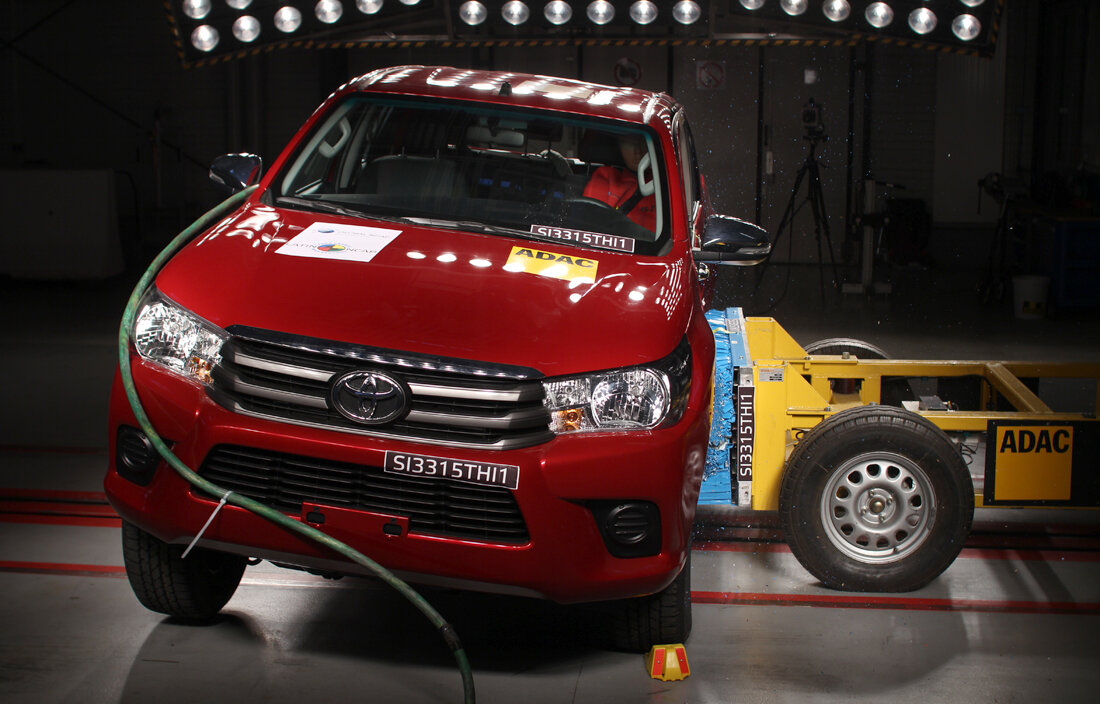With Five Stars For Adult Occupant The Toyota New Hilux Is The First Pick Up Tested By Latin NCAP
The latest Latin NCAP crash tests results continue to show important progress in car safety in Latin America but also expose the sub-standard safety levels offered in some of the region’s major markets. Latin NCAP is continuing to champion improved levels of adult and child occupant protection which in too many countries still fall below minimum UN safety standards. The results show an encouraging five star adult rating by the Toyota New Hilux but a disappointing zero stars in adult occupant safety by the Hyundai Grand i10.
The Toyota Hilux achieved five stars in Adult Occupant Protection and four stars in Child Occupant Protection. The car’s structure is robust and the three standard airbags and seatbelts protect occupants well in front collision. The car also offers good protection in side impact. The Hilux fits three frontal airbags (driver head and chest, driver knees and passenger head and chest), ABS in 4 channels, and seatbelt reminders for frontal passengers as standard in all versions. The tested version is made in Thailand and imported to some markets in Latin America. Latin NCAP will also test the Argentinean version of this model as soon as it becomes available in the market later in 2015.
The basic version of the Hyundai Grand i10, made in India and purchased in Chile, scored zero stars in Adult Occupant Protection and two stars Child Occupant Protection. Comparing this unit to the model tested by Euro NCAP, there are clear differences in the equipment levels as the European basic version offers frontal and side airbags. Moreover the European version provides child seat ISOFIX anchorages and the anti-skid technology, electronic stability control (ESC) added to a stable structure, resulting in a four star rating by Euro NCAP. The unit tested by Latin NCAP had no airbags, no ISOFIX anchorages and no ESC equipment and also presents an unstable performance of the structure. This model was recently launched in markets like Argentina with more safety equipment than the one tested by Latin NCAP, however its poor performing structure may still reduce passengers´ protection.
María Fernanda Rodríguez, Latin NCAP President said: “These are very ambiguous results. On one hand, the result obtained by the Toyota Hilux is encouraging and demonstrates the commitment for road safety and the concern for users. On the other hand, it is sad that the Hyundai Grand i10 offered in Latin America is different in terms of safety to the one offered in Europe. Given this result and knowing that Hyundai is a brand with presence in many markets around the world, where it sells the same products, they should offer the same safety level in all the countries. Moreover I hope that this is a wake-up call to governments and that they consider mandating adequate safety levels in all vehicles and for all citizens”.
Alejandro Furas, Latin NCAP Secretary General said: “the encouraging result of the first pick up tested in Latin NCAP achieving five stars for adult and four stars child occupant protection is good news and very relevant for our region. On the other hand it is disappointing that we still find major global manufacturers offering models, with the same or similar look in several regions with completely different safety performance and structure. We call on Latin America car company leaders, who make the decisions of which models and specification to import, to demonstrate their commitment to the safety of their customers by only offering for sale vehicles that will pass the UN’s minimum crash test standards. We also make a call for all Latin American governments to mandate these UN regulations in the interests of improving the safety of their citizens. Action is needed urgently as Latin America is still suffering from levels of vehicle safety that are twenty years behind Europe and the United States”
Latin NCAP is pleased to announce that more results will be released this year at the end of September, November and December. In addition to the existing supporters FIA Foundation, Global New Car Assessment Programme (Global NCAP), International Consumer Research and Testing (ICRT) and the Inter-American Development Bank (IDB,) Latin NCAP is also being assisted in 2015 by the Bloomberg Philanthropies Global Road Safety Initiative.
About Latin NCAP
The Latin New Car Assessment Programme (Latin NCAP) was launched in 2010 to develop a regional system of independent crashworthiness and safety rating across Latin America and Caribbean (LAC). Latin NCAP replicates similar consumer testing programmes developed over the last thirty years in North America, Europe, Asia and Australia, and which have proved to be very effective in improving the safety of motor vehicles. Since 2010 Latin NCAP has published the results of more than fifty cars in six test phases.
Latin NCAP is an Associate member of Global NCAP and supports the United Nations Decade of Action for Road Safety 2011-2020 especially the vehicle pillar of the Global Plan for the Decade.
More information at www.latinncap.com






